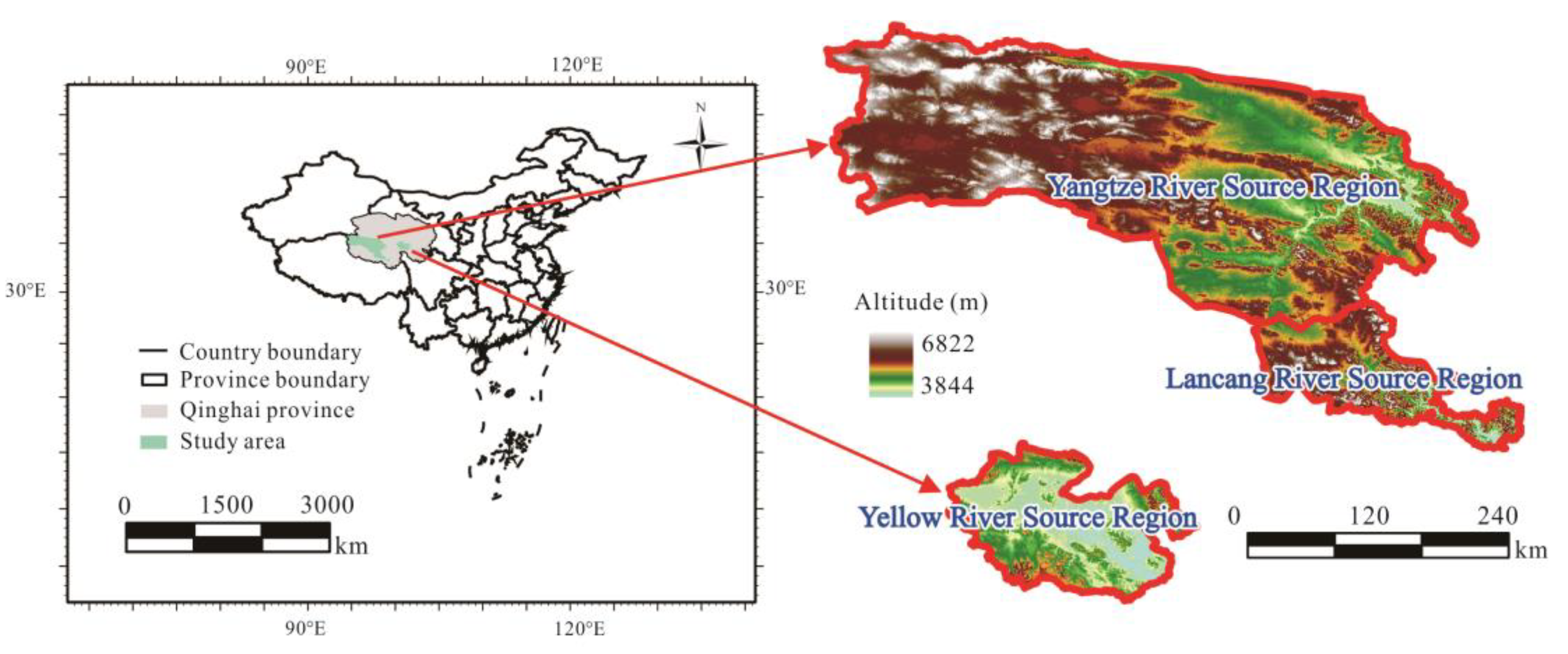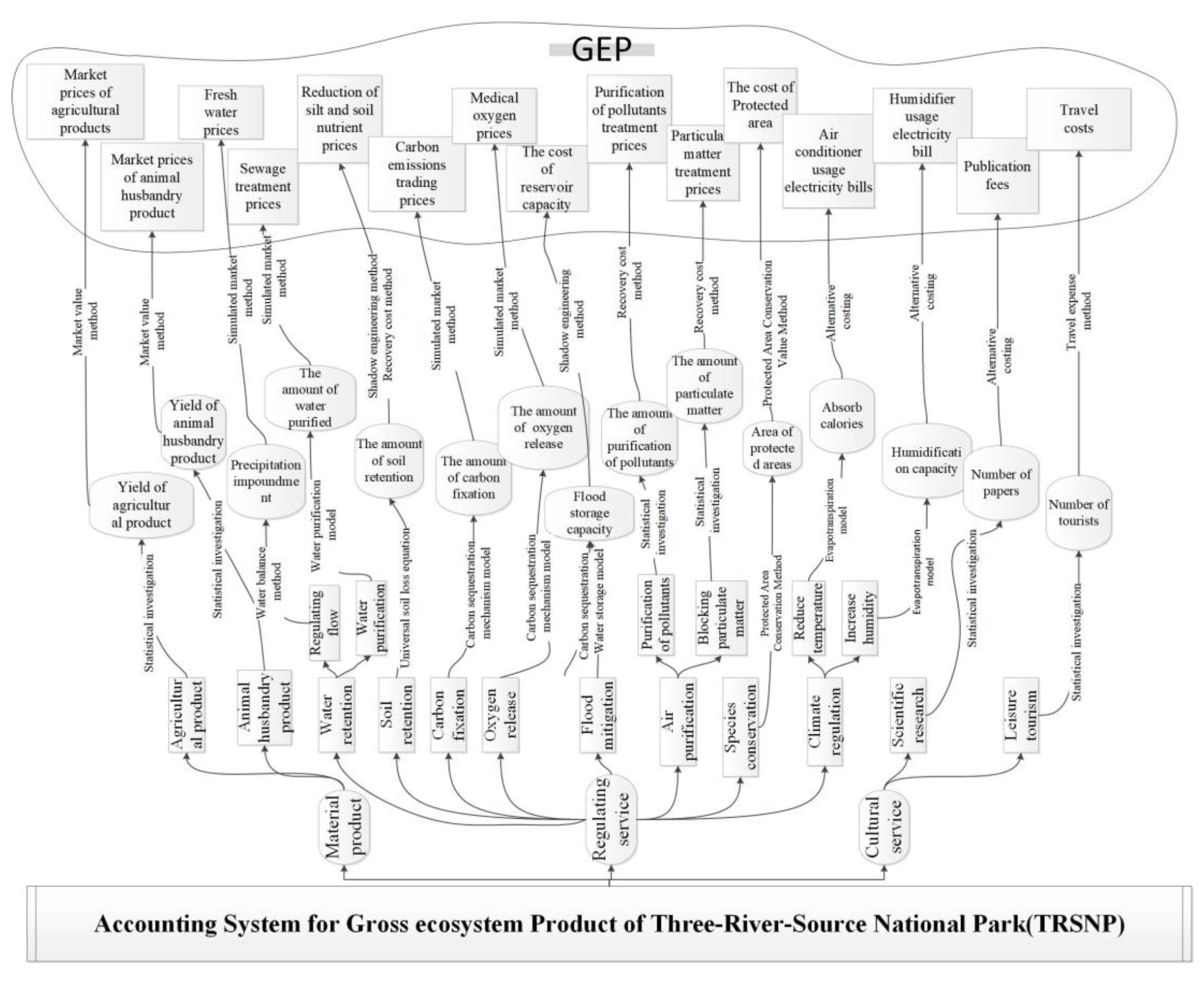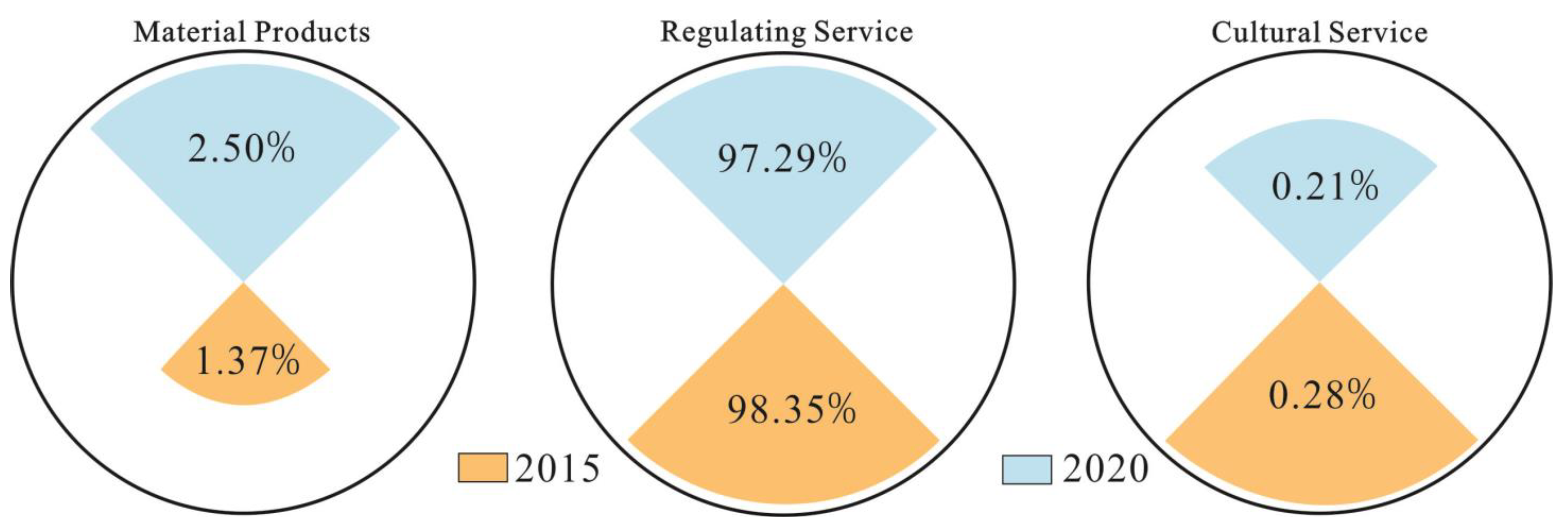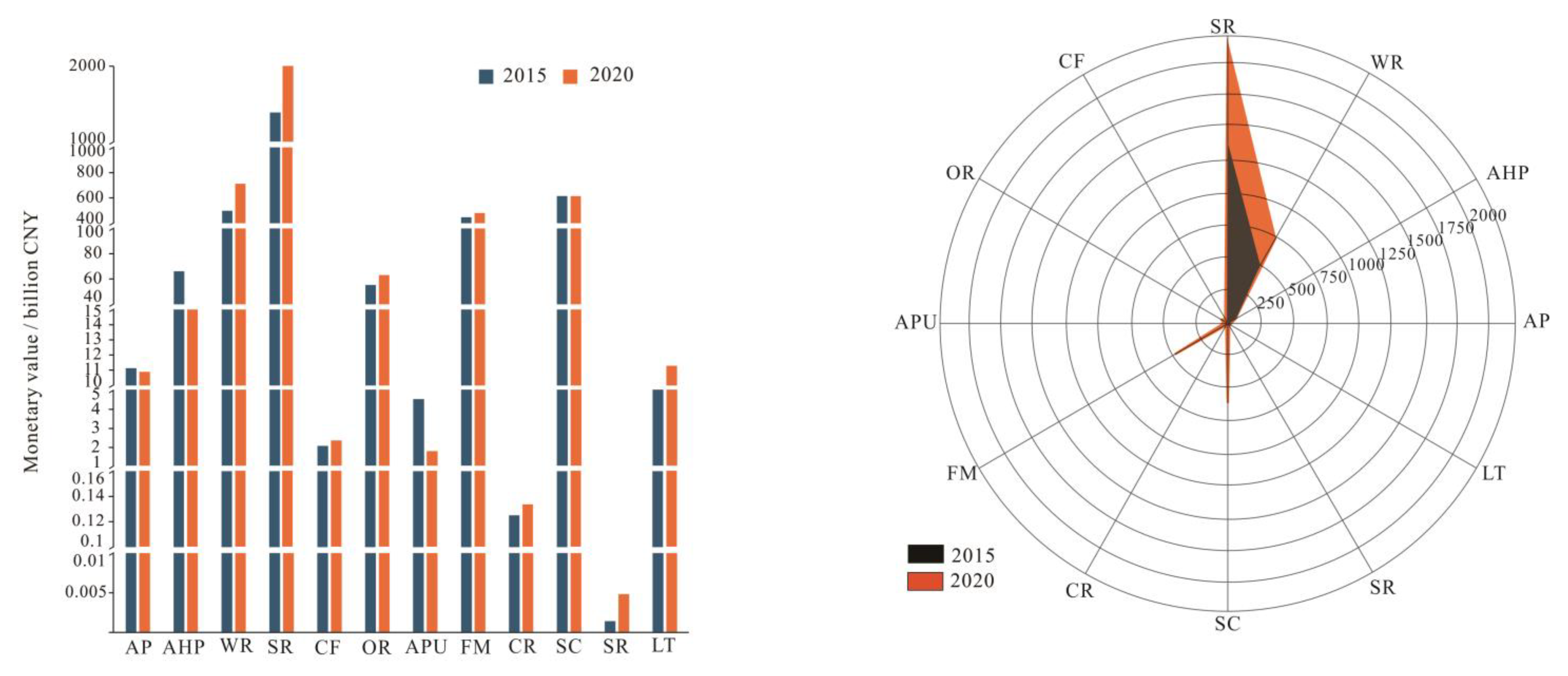Framework Construction and Application of Gross Ecosystem Product (GEP) in the Three-River-Source National Park (TRSNP) in China
Abstract
1. Introduction
2. Materials and Methods
2.1. Study Area
2.2. Data Source
2.3. Research Methods
2.3.1. Water Retention, Water Purification, and Soil Retention
2.3.2. Carbon Fixation and Oxygen Release
2.3.3. Flood Mitigation
2.3.4. Climate Regulation
2.3.5. Statistical Investigation
2.3.6. Monetary Value Accounting
3. Results
3.1. Create the Indicator System
3.2. Establishing an Accounting System for the TRSNP’s GEP
3.3. Biophysical Value and Change Characteristics of Ecosystem Products in the TRSNP
3.4. Monetary Value and Change Characteristics of Ecosystem Products in the TRSNP
3.5. Monetary Values in the Different Parks Within the TRSNP
4. Discussion
4.1. Verification of the GEP Accounting Results
4.2. Analysis of Changes in the TRSNP’s GEP
- (1)
- Exploring value-added models for agricultural and pastoral products is essential to broaden the income sources for farmers and herders: Under the influence of grazing prohibition policies, the output of agricultural and livestock products in the TRSNP has decreased. The government has provided certain subsidies to herders as supplementary income, which is particularly applicable during the transitional phase of national park development. As the national park evolves, herders should leverage proactive income strategies to promote sustainable economic development. This includes exploring pathways to enhance the value of agricultural and animal husbandry products, such as adopting new technologies to increase productivity and creating ecosystem product brands to raise products’ added value. Such initiatives can augment herders’ proactive income, thereby reducing reliance on government subsidies. Additionally, the establishment of ecological management positions specifically for herders affected by decreased income due to grassland restoration could provide alternative income sources, addressing the conflict between ecological security and the livelihoods of herders.
- (2)
- Implementing differentiated restoration in various regions to explore methods of realizing soil conservation value: Ecological protection and construction projects in the Three-River-Source region have yielded significant results, particularly in soil retention, with the Lancang River source region exhibiting the highest regulatory services among the three major regions. Continued investment in ecological protection and construction projects, such as comprehensive management of black soil grasslands, should be prioritized.
- (3)
- With the construction of national parks, the attention of research teams and other stakeholders towards ecologically significant areas has increased, subsequently enhancing their research value. This allows for more scientific investigations to be conducted provided that the ecological environment remains undisturbed, thereby laying a foundational basis for further protection and restoration efforts. Following the establishment of national parks, public awareness of the Three-River-Source region’s beautiful environment and rich cultural heritage has deepened, leading to an increase in visitor numbers to the park. However, it is crucial to pay attention to the potential ecological security issues that may arise from the growing influx of tourists. It is recommended to calculate the carrying capacity for visitors to ensure sustainable development of the ecotourism sector, thus achieving a win–win situation that harmonizes ecological protection with economic development.
4.3. Innovations, Limitations, and Future Perspectives
- (1)
- In contrast to the studies by scholars like Du et al. [39], which focused on the GEP assessments of five national parks, our research includes both material products and cultural service values, resulting in more comprehensive assessment indicators that encompass ecosystem material products, ecosystem regulatory services, and ecosystem cultural services. Unlike the “Guidelines”, this study incorporates scientific research projects into cultural services, facilitating further exploration of cultural service ecosystem products in national parks. The indicators of this study also cover key factors across multiple dimensions of ecosystem products, ensuring a thorough consideration of the comprehensiveness and representativeness of the assessment indicators for TRSNP.
- (2)
- This study incorporates the mature InVEST model for assessing ecosystem service values, broadening the methodological approaches beyond those outlined in the “Guidelines”.
- (3)
- The first batch of localized parameters for the ecosystem product value assessments of the five national parks faced challenges in data acquisition. This research improves real-time accuracy by determining parameters via the correlation of data from relevant monitoring centers, thus enhancing the reliability and precision of the value assessment system for the TRSNP compared to previous studies.
- (4)
- In the assessment of regulating services, this study included local precipitation and NPP factors within the ecosystem product value assessment framework, thereby correcting some of the inaccuracies associated with the equivalency factor method to a certain extent.
5. Conclusions
- (1)
- This study has successfully constructed a comprehensive accounting framework that encompasses material products, regulating services, and cultural services. In addressing the inadequacy of existing research indicators and the limited diversity of methodologies, this framework employs different calculation models and parameter calibration methods tailored to various types of ecosystem products, thereby precisely quantifying the ecosystem product value within TRSNP. The constructed accounting system has improved the accuracy of ecosystem product valuation and provided a scientific basis for evaluating the ecological protection effect of TRSNP.
- (2)
- The total value of ecosystem products in TRSNP increased by 31.19% from 2015 to 2020. Driven by policies such as grazing bans and the restoration of grasslands, the value of material products saw a decrease during the same period, while the value of regulating services experienced an increase. Notably, among the regulating services, the value associated with soil conservation emerged as the highest.
- (3)
- The value of regulating services varies across different regions due to the influences of land use types and soil erosion types was highlighted. Among these, the value of regulating services per unit area is highest in the Lancang River source region, followed by the Yellow River source region, and the lowest is in the Yangtze River source region.
- (4)
- Exploring pathways for enhancing the value of agricultural and animal husbandry products is recommended to increase the overall value of agro-pastoral products and broaden income sources for herders. Special attention should be given to soil protection and restoration projects in the Yangtze and Yellow River source regions. Taking the Lancang River source region as a pilot, strategies should be investigated for the trading of ecological resource rights associated with soil retention regulating services to realize the intrinsic value of soil retention.
Author Contributions
Funding
Data Availability Statement
Acknowledgments
Conflicts of Interest
References
- Pekor, A.; Miller, J.R.B.; Flyman, M.V.; Kasiki, S.; Kesch, M.K.; Miller, S.M.; Uiseb, K.; der Merve, V.L.P.A. Fencing Africa’s protected areas: Costs, benefits, and management issues. Biol. Conserv. 2019, 229, 67–75. [Google Scholar] [CrossRef]
- Silva, J.; Dias, T.; Cunha, H.F.A. Funding deficits of protected areas in Brazil. Land Use Policy 2021, 100, 104926. [Google Scholar] [CrossRef]
- Zhang, Y.; Xiao, X.; Cao, R.; Zheng, C.; Guo, Y.; Gong, W.; Wei, Z. How important is community participation to eco-environmental conservation in protected areas? From the perspective of predicting locals’ pro-environmental behaviours. Sci. Total Environ. 2020, 739, 139889. [Google Scholar] [CrossRef] [PubMed]
- Zhang, Y.J. Exploration on the Sinicization o f the National Park Concept. Frontiers 2022, 4, 66–79. [Google Scholar]
- Kang, X.; Du, M.; Zhao, L.; Liu, Q.; Liao, Z.; Su, H.; Xiang, T.; Gou, C.; Liu, N. Integrity-centered framework for determining protected areas boundary: An application in the China’s national park. Ecol. Inform. 2024, 84, 102885. [Google Scholar] [CrossRef]
- Xue, S.; Fang, Z.; Bai, Y.; Alatalo, J.M.; Yang, Y.; Zhang, F. The next step for China’s national park management: Integrating ecosystem services into space boundary delimitation. J. Environ. Manag. 2023, 329, 117086. [Google Scholar] [CrossRef]
- Wei, D.; Feng, A.; Wu, M. Analysis of the resources value of Three-River-Source National Park based on ecological civilization. Int. J. Geoherit. Parks 2020, 8, 173–184. [Google Scholar] [CrossRef]
- Wang, Y.; Lü, Y.; Lü, D.; Yin, L.; Wang, X. Climate change and its ecological risks are spatially heterogeneous in high-altitude region: The case of Qinghai-Tibet plateau. Catena 2024, 243, 108140. [Google Scholar] [CrossRef]
- Chiodo, E.; Fantini, A.; Dickes, L.; Arogundade, T.; Lamie, D.; Assing, L.; Stewart, C.; Salvatore, R. Agritourism in Mountainous Regions-insights from anInternational Perspective. Sustainability 2019, 13, 3715. [Google Scholar] [CrossRef]
- Wanner, A.; Pröbstl-Haider, U.; Feilhammer, M. The future of Alpine pastures—Agricultural or tourism development? Experiences from the German Alps. J. Outdoor Recreat. Tour. 2021, 35, 100405. [Google Scholar] [CrossRef]
- Fu, M.; Tian, J.; Zhu, Y.; Tian, Y.; Zhao, Z.; Li, J. Identification of functional zones and methods of target management in Sanjiangyuan National Park. Biodivers. Sci. 2017, 1, 71–79. [Google Scholar] [CrossRef]
- Wu, J.; Wu, G.; Zheng, T.; Zhang, X.; Zhou, K. Value capture mechanisms, transaction costs, and heritage conservation: A case study of Sanjiangyuan National Park, China. Land Use Policy 2020, 90, 104246. [Google Scholar] [CrossRef]
- Kumar, P. The Economics of Ecosystems and Biodiversity Ecological and Economic Foundations, Publisher; Rensselaer Polytechnic Institute, Department of Economics: Troy, NY, USA, 2011; pp. 123–150. [Google Scholar]
- Hannon, B. The use of analogy in biology and economics: From biology to economics, and back. Struct. Change Econ. Dyn. 1997, 8, 471–488. [Google Scholar] [CrossRef]
- Ouyang, Z.; Zhu, C.Q.; Yang, G.B.; Xu, W.H. Gross ecosystem product: Concept, accounting framework and case study. Acta Ecol. Sin. 2013, 21, 6747–6761. [Google Scholar] [CrossRef]
- Ouyang, Z.; Song, C.; Zheng, H.; Polasky, S.; Xiao, Y.; Bateman, L.J.; Liu, J.; Ruckelshaus, M.; Shi, F.; Xiao, Y.; et al. Using gross ecosystem product (GEP) to value nature in decision making. Proc. Natl. Acad. Sci. USA 2020, 25, 14593–14601. [Google Scholar] [CrossRef] [PubMed]
- Chen, H. At least two accounting systems for Gross Ecosystem Product (GEP) are needed. J. Environ. Manag. 2024, 370, 122429. [Google Scholar] [CrossRef]
- Zhang, L.; Chen, X.; Liang, T.; Wang, H.; Hao, C.; Ren, Y.; Li, Y.; Wu, S. Research Progress, Problems and Prospects of Ecosystem Products Value Accounting in China. Res. Environ. 2023, 4, 743–756. [Google Scholar]
- Li, Y.; Xie, L.M.; Mo, X.; Zhou, S.J.; Zhang, Z.M.; Zhang, M.X. Accounting and Spatio-temporal Dynamic Analysis of the Gross Ecosystem Product (GEP) of Wetlands in Jiangxi Province. J. Ecol. Rural. Environ. 2024, 6, 738–748. [Google Scholar]
- Zhang, W.W.; Liu, Y.; Feng, Q.; Wang, Y.P.; Yang, S.Q. Ecosystem services for coupled human and environment systems. Prog. Geogr. 2018, 37, 139–151. [Google Scholar]
- Boumans, R.; Roman, J.; Altman, I.; Kaufman, L. The Multiscale Integrated Model of Ecosystem Services (MIMES): Simulating the interactions of coupled human and natural systems. Ecosyst. Serv. 2015, 12, 30–41. [Google Scholar] [CrossRef]
- Pei, X.; Yu, Q.R.; Liu, C.L.; Zhang, J.P.; Qiao, Q.; Chen, L.; Liu, X.N. Analysis of Pricing Method of Regulating Service in the Accounting of Ecosystem Products. Environ. Prot. 2024, Z1, 31–35. [Google Scholar]
- Tan, L.; Guo, G.; Li, S. The Sanjiangyuan Nature Reserve Is Partially Effective in Mitigating Human Pressures. Land 2021, 11, 43. [Google Scholar] [CrossRef]
- Zhu, Y.; Jia, P.; Liu, Y. Spatiotemporal evolution effects of habitat quality with the conservation policies in the Upper Yangtze River, China. Sci. Rep. 2025, 15, 5972. [Google Scholar] [CrossRef]
- Hu, X.W.; Lian, E.H.; Zhuoma, C. Optimization of Land Use Structure and Spatial Layout of Sanjiangyuan National Park. Qinghai J. Ethnol. 2022, 2, 190–199. [Google Scholar]
- Zhang, T.; Jiang, F.; Zhang, J.; Cai, Z.; Gao, H.; Gu, H.; Song, P. A review of wildlife conservation and management strategies of Sanjiangyuan National Park. Acta Theriol. Sin. 2023, 43, 193–205. [Google Scholar]
- Zhou, X.T.; Sun, W.Y.; Mu, X.M.; Song, X.Y.; Zhao, G.J. Spatiotemporal variation and influencing factors of water conservation capacity in Three-River Headwaters region from 1990 to 2020. Acta Ecol. Sin. 2023, 23, 9844–9855. [Google Scholar]
- Gao, X.L.; Feng, Q.; Li, Z.X.; Deng, X.H.; Xue, J. Spatio-temporal pattern and influencing factors of water in the Three-River-Source region. Acta Ecol. Sin. 2024, 16, 1–13. [Google Scholar]
- Lv, L.; Ren, T.; Sun, C.; Zheng, D.; Wang, H. Spatial and temporal changes of water supply and water conservation function in Sanjiangyuan National Park from 1980 to 2016. Acta Ecol. Sin. 2020, 40, 993–1003. [Google Scholar]
- Natural Capital Project. InVEST 0.0 User’s Guide. Available online: https://storage.googleapis.com/releases.naturalcapitalproject.org/invest-userguide/latest/zh/index.html# (accessed on 1 July 2024).
- Chen, S.; Li, X.; Qian, Z.; Wang, S.; Wang, M.; Liu, Z.; Li, H.; Xia, H.; Zhao, Z.; Li, T.; et al. Drought trend and its impact on ecosystem carbon sequestration in Lancang-Mekong River Basin. Acta Geogr. Sin. 2024, 79, 747–764. [Google Scholar]
- Rao, E.; Xiao, Y.; Ouyang, Z. Assessment of Flood Regulation Service of Lakes and Reservoirs in China. Prog. Geogr. 2014, 8, 1356–1365. [Google Scholar]
- Fang, J.; Xu, L.; Lu, Q. Ecological security patterns of Chinese lakes based on ecosystem service values assessment and human threat factors evaluation. Ecol. Inform. 2024, 82, 102754. [Google Scholar] [CrossRef]
- Huang, L.; Li, J.; Zhang, H.; Li, Y.; Wang, H.; Fan, J. Accounting and assessment of grassland ecological values. Acta Pratacult. Sin. 2024, 33, 47–63. [Google Scholar]
- Yan, X.; Cao, G.; Cao, S.; Yuan, J.; Zhao, M.; Tong, S.; Li, H. Spatiotemporal variations of water conservation and its influencing factors in the Qinghai Plateau, China. Ecol. Indic. 2023, 155, 111047. [Google Scholar] [CrossRef]
- Baró, F.; Chaparro, L.; Gómez-Baggethun, E.; Langemeyer, J. Contribution of Ecosystem Services to Air Quality and Climate Change Mitigation Policies: The Case of Urban Forests in Barcelona, Spain. J. Hum. Environ. 2014, 43, 466–479. [Google Scholar] [CrossRef]
- Xu, H.; Yang, C.; Li, Q. Spatial-temporal variations of ecosystem service value in Sanjiangyuan National Park. Chin. J. Ecol. 2024, 43, 1881–1890. [Google Scholar]
- He, X. Evaluation of the grassland ecosystem services in the source region of three rivers. Qinghai Pratacult. 2021, 30, 29–36. [Google Scholar]
- Du, A.; Shen, Y.; Xiao, Y.; Ouyang, Z. Research on accounting of ecological products value in National Parks. Acta Ecol. Sin. 2023, 1, 208–218. [Google Scholar]
- Huang, T.; Zhao, H.; Zhao, Y.; Ren, J.; Li, Z.; Li, B. Soil Erosion and Its Spatial Distribution Characteristics in Three-River-Source National Park. Bull. Soil Water Conserv. 2023, 43, 95–103+110. [Google Scholar]
- Song, C.; Ouyang, Z. Gross Ecosystem Product accounting for ecological benefits assessment: A case study of Qinghai Province. Acta Ecol. Sin 2020, 10, 3207–3217. [Google Scholar]
- Wang, L.; Xiao, Y.; Ouyang, Z.; Wei, Q.; Bo, W.; Zhang, J.; Ling, R. Gross ecosystem product accounting in the national key ecological function area: An example of Arxan. China Polulation Resour. Environ. 2017, 27, 146–154. [Google Scholar]
- Pema, D.; Xiao, Y.; Wang, L. Assessment of ecological conservation effect in Xishui county based on gross ecosystem product. Acta Ecol. Sin. 2020, 40, 499–509. [Google Scholar]
- Zhang, C.; Zhang, Y. Evaluation of Ecosystem Services in Qilian Mountain National Park, Qinghai Province. Environ. Prot. 2019, 47, 41–47. [Google Scholar] [CrossRef]





| Data Type | Data Usage | Data Sources |
|---|---|---|
| Land cover and land use | Explanation of land use and land cover changes, etc., as natural environmental data for the InVEST model | National Cryosphere Desert Data Center (http://www.ncdc.ac.cn, accessed on 23 June 2023) |
| DEM | Extraction of slope, elevation, etc., as natural environmental data for the InVEST model and as foundational data for calculating other regulating services | Big Earth Data Platform for Three Poles (https://portal.casearth.cn/poles, accessed on 20 June 2023) |
| Precipitation | Used for the calculation of regulating service quantities | National Earth System Science Data Center (https://www.geodata.cn, accessed on 8 July 2023) |
| Evaporation | Used for the calculation of regulating service quantities | Institute of Tibetan Plateau Research, Chinese Academy of Sciences (http://data.tpdc.ac.cn, accessed on 23 June 2023) |
| Soil organic matter content | Used for the calculation of regulating service quantities | Institute of Tibetan Plateau Research, Chinese Academy of Sciences (http://data.tpdc.ac.cn, accessed on 30 July 2023) |
| Lake area | Basic data for calculating the physical quantity of flood regulation and storage in ecosystem services | Big Earth Data Platform for Three Poles (https://portal.casearth.cn/poles, accessed on 21 June 2023) |
| Statistical data | Basic data for material products and cultural services | Qinghai Province Statistical Yearbook (https://kns.cnki.net/kns8s/?classid=HHCPM1F8, accessed on 23 June 2023) |
| Account Item | Biophysical Value Accounting Method | Monetary Value Accounting Method | ||
|---|---|---|---|---|
| Material product | Agricultural product (AP) | Statistical investigation | Market value method | |
| Animal husbandry product (AHP) | Statistical investigation | Market value method | ||
| Regulating service | Water retention (WR) | Regulating flow | Water balance method | Simulated market method |
| Water purification | Water purification model | Simulated market method | ||
| Soil retention (SR) | Soil fixation | Universal soil loss equation | Shadow engineering method; Recovery cost method | |
| Carbon fixation (CF) | Carbon fixation | Carbon sequestration mechanism model | Simulated market method | |
| Oxygen release (OR) | Oxygen release | Carbon sequestration mechanism model | Simulated market method | |
| Air purification (APU) | Absorption of gas pollutant | Statistical investigation | Recovery cost method | |
| Retarded particulate matter | Statistical investigation | Recovery cost method | ||
| Flood mitigation (FM) | Flood mitigation | Water storage model | Shadow engineering method | |
| Climate regulation (CR) | Reduce the temperature | Evapotranspiration model | Alternative costing | |
| Increase humidity | Evapotranspiration model | Alternative costing | ||
| Specie conservation (SC) | Specie conservation | Protected Area conservation method | Protected area conservation value method | |
| Cultural service | Scientific research (SRE) | Scientific research | Statistical investigation | Alternative costing |
| Leisure tourism (LT) | Leisure tourism | Statistical investigation | Travel expense method |
| Functional Category | Account | 2015 | 2020 | ||||
|---|---|---|---|---|---|---|---|
| Biophysical Value | Monetary Value (Billion CNY) | Proportion of Monetary Value (%) | Biophysical Value | Monetary Value (Billion CNY) | Proportion of Monetary Value (%) | ||
| Material product | Agricultural product (t) | 2.34 × 104 | 11.14 | 0.36 | 1.68 × 104 | 10.90 | 0.27 |
| Animal husbandry product (t) | 1.65 × 105 | 66.14 | 2.14 | 1.12 × 105 | 44.74 | 1.10 | |
| Regulating service | Regulating flow (m3) | 2.72 × 1010 | 498.56 | 16.14 | 3.9 × 1010 | 712.71 | 17.59 |
| Water purification (kg) | 1.59 × 106 | 0.09 | 0.00 | 1.6 × 106 | 0.09 | 0.00 | |
| Soil-fixation (t) | 1.51 × 1010 | 1382.22 | 44.75 | 2.30 × 1010 | 2108.34 | 52.03 | |
| Carbon fixation (t) | 9.48 × 106 | 2.04 | 0.07 | 1.08 × 107 | 2.33 | 0.06 | |
| Oxygen release (t) | 6.90 × 106 | 55.19 | 1.79 | 7.89 × 106 | 63.08 | 1.56 | |
| Purification of pollutants (t) | 28.86 | 3.65 | 0.12 | 12.14 | 1.53 | 0.04 | |
| Blocking particulate matter (t) | 28.6 | 0.86 | 0.03 | 7.60 | 0.23 | 0.01 | |
| Flood mitigation | 5.19 × 109 | 446.76 | 14.46 | 5.6 × 109 | 481.14 | 11.87 | |
| Reduce temperature | 3.48 × 1011 | 0.13 | 0.00 | 3.8 × 1011 | 0.13 | 0.00 | |
| Increase humidity | 5.63 × 108 | 0.00 | 0.00 | 6.0 × 108 | 0.00 | 0.00 | |
| Species conservation | 1.23 × 105 | 615.50 | 19.93 | 1.23 × 105 | 615.50 | 15.19 | |
| cultural service | Scientific research | 12 | 0.00 | 0.00 | 39.00 | 0.00 | 0.00 |
| Leisure tourism | 87.2 | 6.49 | 0.21 | 160.00 | 11.30 | 0.28 | |
| Total | 3088.76 | 100 | 4052.03 | 100 | |||
Disclaimer/Publisher’s Note: The statements, opinions and data contained in all publications are solely those of the individual author(s) and contributor(s) and not of MDPI and/or the editor(s). MDPI and/or the editor(s) disclaim responsibility for any injury to people or property resulting from any ideas, methods, instructions or products referred to in the content. |
© 2025 by the authors. Licensee MDPI, Basel, Switzerland. This article is an open access article distributed under the terms and conditions of the Creative Commons Attribution (CC BY) license (https://creativecommons.org/licenses/by/4.0/).
Share and Cite
Jia, P.; Chen, J.; Gao, D.; Zhu, Y.; Wang, X. Framework Construction and Application of Gross Ecosystem Product (GEP) in the Three-River-Source National Park (TRSNP) in China. Land 2025, 14, 642. https://doi.org/10.3390/land14030642
Jia P, Chen J, Gao D, Zhu Y, Wang X. Framework Construction and Application of Gross Ecosystem Product (GEP) in the Three-River-Source National Park (TRSNP) in China. Land. 2025; 14(3):642. https://doi.org/10.3390/land14030642
Chicago/Turabian StyleJia, Peihong, Jing Chen, Diangong Gao, Yuxin Zhu, and Xinyue Wang. 2025. "Framework Construction and Application of Gross Ecosystem Product (GEP) in the Three-River-Source National Park (TRSNP) in China" Land 14, no. 3: 642. https://doi.org/10.3390/land14030642
APA StyleJia, P., Chen, J., Gao, D., Zhu, Y., & Wang, X. (2025). Framework Construction and Application of Gross Ecosystem Product (GEP) in the Three-River-Source National Park (TRSNP) in China. Land, 14(3), 642. https://doi.org/10.3390/land14030642





